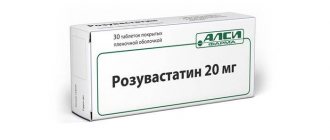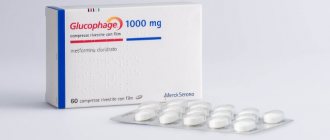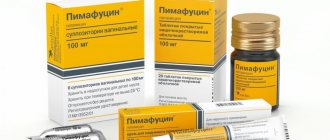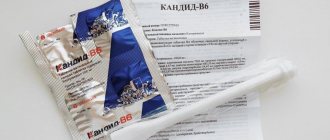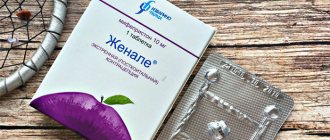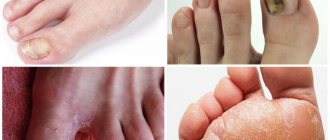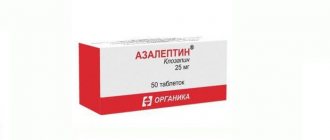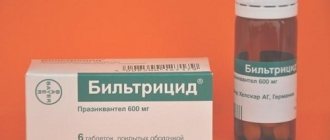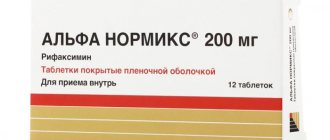Terbinafine tablets - instructions for use
The antifungal drug Terbinafine is a broad-spectrum agent used to treat most types of fungal infections - mycoses of the skin of the feet, hands, nails, hair and mucous membranes. The tablets have a fungicidal effect on species such as yeasts, dermatophytes, candida fungi, dimorphic fungi and molds. The active substance inhibits the synthesis of sterols in fungal cells, which prevents their division and leads to death.
Composition of Terbinafine
Terbinafine tablets are white or yellowish-white in color with a chamfer and a score, weighing 250 mg, packaged in contour cells of 10, 14 or 28 pieces, packed in cardboard boxes of one, two or three cells per package. The main active ingredient of the drug is terbinafine hydrochloride, the content of which is 200 mg. The full composition of the drug is presented in the table below.
| Substance | Content in one tablet, mg |
| Terbinafine hydrochloride | 200 |
| Microcrystalline cellulose | 8 |
| Croscarmellose sodium | 8 |
| Hyprolose | 2,5 |
| Silica | 10 |
| Calcium stearate | 5 |
| Lactose monohydrate | 30 |
Pharmacodynamics and pharmacokinetics
Terbinafine suppresses the initial stage of sterol synthesis in the fungal cell membrane, which leads to ergosterol deficiency and intracellular accumulation of squalene, which causes the death of the microorganism cell. Terbinafine works by inhibiting the enzyme squalene epoxidase in the cell membrane of the fungus. When taken orally, concentrations of the drug are created that provide a fungicidal effect.
After oral administration, the maximum concentration of the active substance in the blood plasma is reached after two hours. During long-term therapy, it accumulates in the stratum corneum of the skin and nails. The drug is metabolized by the liver, excreted by the kidneys, and partially through the skin. It is excreted in breast milk through the mammary glands during lactation in women. In patients with impaired renal and liver function, the elimination of the drug from the body is slowed down, which leads to higher concentrations in the blood.
Indications for use
Terbinafine tablets are prescribed in cases where local therapy - antifungal treatment, the use of special creams or sprays - does not provide sufficient results. When taken orally, the remedy is not effective against the fungus multicolored lichen - a topical medication is required. The tablets help in the systemic treatment of the following diseases of the skin, nails and mucous membranes:
- onychomycosis (fungal infections of nails, skin, foot fungus, mycoses of the feet);
- microsporia, trichophytosis (mycoses of the scalp);
- candidiasis (skin and mucous membranes);
- dermatomycosis of the trunk and extremities, requiring systemic treatment.
Release form and composition
Terbinafine is available in the following dosage forms:
- Cream for external use 1%: homogeneous, white, with a characteristic faint odor (10, 15, 30 g each in aluminum or polymer tubes, 1 tube in a cardboard box; 30 g each in dark glass jars, 1 jar in a cardboard box);
- Spray for external use 1%: transparent, colorless or light yellow liquid with a characteristic odor of ethanol; slight opalescence is allowed (10 or 20 g in bottles with a microspray, 1 bottle in a cardboard box);
- Tablets: white with a yellowish tint or white, scored and chamfered (0.25 g: 7, 10 pcs. in strip packs, 1-4, 5, 10 packs in a cardboard box; 0.125 g: 7, 10 each pcs in blister packs, 1-4 packs in a cardboard pack; 14, 28, 50, 100 pcs in polymer cans, 1 can in a cardboard pack).
The composition of 1 g of cream for external use includes:
- Active substance: terbinafine – 0.01 g (in the form of hydrochloride);
- Excipients: benzyl alcohol, Tween 60 (polysorbate 6), sorbitan monostearate, cetyl alcohol, cetyl palmitate, sodium hydroxide, isopropyl myristate, purified water.
The composition of 1 g of spray for external use includes:
- Active substance: terbinafine – 0.01 g (in the form of hydrochloride);
- Auxiliary components: macrogol 400, povidone K17, propylene glycol, 95% ethanol, macrogol glyceryl hydroxystearate, purified water.
1 tablet contains the active substance: terbinafine – 0.125 or 0.25 g (in the form of hydrochloride).
Auxiliary components of tablets:
- 0.125 g: primellose, hydroxypropylcellulose, microcrystalline cellulose, silicon dioxide, calcium stearate;
- 0.25 g: microcrystalline cellulose, hydroxypropylcellulose (hyprolose), croscarmellose sodium, colloidal silicon dioxide, calcium stearate, lactose monohydrate.
Directions for use and dosage
The treatment regimen with Terbinafine tablets is developed taking into account the diagnosis and depends on the type of skin infection, the degree of damage to the skin of the extremities or nail plates. The manufacturer's recommended average dose of Terbinafine is 250 mg once a day. The drug is taken after meals, washed down with a sufficient amount of liquid. The duration of the course depends on the severity of the condition and the location of the yeast infection:
- for onychomycosis: 6-12 weeks;
- for fungal skin infections: interdigital localization - 2-6 weeks; lower legs and torso - 2-4 weeks; fungus such as candida and fungi of the scalp - from one month.
How to use it correctly?
Before using Terbinafine cream or ointment, you need to read the instructions and pay attention to the features when using this drug.
The regimen and duration of treatment directly depends on the disease, location of the lesion and severity. Only a doctor can make an accurate diagnosis and prescribe the correct treatment.
Application for dermatomycosis of the skin and feet
Ringworm is a skin infection caused by dermatophyte fungi that can appear on the legs, feet, and palms of the hands.
Step-by-step treatment:
- Wash and dry affected skin;
- After a few minutes, apply a thin layer of Terbinafine cream;
- The procedure is performed once a day for one week.
In case of severe forms of dermatomycosis of the skin:
- Wash and dry the affected area;
- After a few minutes, apply a thin layer of Terbinafine cream;
- Carry out the procedure 2 times a day for 7-14 days.
Drugs combined with a glucocorticoid, either a hormone or an antibacterial drug are added to local treatment.
Application for diaper rash
Diaper rash caused by a fungus, especially superficial candidiasis, appears in large folds, for example, under the mammary glands, between the buttocks, in the groin area, between the fingers, where the skin moisture is increased.
They appear more often in obese people.
During treatment you should wear loose, not tight, breathable clothing and shoes made of genuine leather.
Step-by-step treatment:
- Wash problem areas with soap;
- Dry with a sterile cloth or allow to dry naturally;
- Apply the cream in a thin layer, slightly rubbing into the skin;
- After applying the cream, it is better to cover the affected areas with gauze at night;
- Application occurs 1-2 times a day for 1-2 weeks.
Use for lichen
Terbinafine is used to treat pityriasis versicolor and pityriasis versicolor.
Step-by-step treatment:
- Wash and dry the damaged area;
- Apply the cream in a thin layer 1-2 times a day for 2 weeks, covering 1 cm of healthy tissue.
In the absence of complete recovery from local treatment, systemic antimycotics are used.
Application for fungus of the nail plate
With onychomycosis of the hands and feet, the fungus affects the nail plates.
Step-by-step treatment:
- Clean nails from varnish and cosmetics;
- Wash thoroughly with soap;
- Steam your feet using a salt bath;
- Then dry with a cloth or naturally;
- Remove the affected area of the nail using a special nail file;
- After a few minutes, apply the cream in a thin layer, covering 1 cm of the healthy area;
- Apply 2 times a day in the morning and evening;
- Treatment lasts a long time, from 3 months to six months, that is, until a healthy nail appears.
For severe forms of lesions, it is better to apply the cream in a thick layer, covering it with gauze. To prevent relapse, you can use antifungal varnishes.
Use for thrush
The mucous membranes of the vagina are affected or vaginal candidiasis appears. Symptoms are itching and burning in the intimate area.
Step-by-step treatment:
- A hygienic procedure is carried out - the damaged surface is washed and dried;
- Apply the cream around the vagina and external genitalia in a thin layer;
- Apply once a day; if itching and redness persist, you can apply twice a day;
- Treatment lasts from 2 to 6 weeks depending on the severity of the lesions.
To achieve a faster effect of treating thrush, it is possible to use an antifungal agent for oral administration, and douching, washing with a soda solution (1 teaspoon per 1 liter of water) and chamomile decoction contribute to the cure.
The cream can be replaced by vaginal antifungal suppositories.
special instructions
If the duration of therapy is insufficient or the tablets are taken irregularly, there is a high risk of recurrence of the infection. If there is no effect, two weeks after the start of treatment, it is necessary to re-identify the causative agent of the fungal infection and clarify its sensitivity to the drug. If the patient suffers from liver disease, the clearance of Terbinafine may be reduced. During therapy there is a risk of exacerbation of psoriasis. During the course, it is important to follow hygiene rules to avoid re-infection through clothing, shoes or underwear.
During pregnancy
Studies examining the safety of the effects of Terbinafine tablets on the health of a pregnant woman and her fetus have not been conducted, therefore the drug is not prescribed during pregnancy; in the instructions for use, this condition of a woman is considered a contraindication. Prescription is contraindicated during breastfeeding, since the active substance of the drug is excreted in breast milk.
?
Indications for use
The instructions for the use of Terbinafine indicate that all forms of the drug are used for diseases that were caused by yeast-like , molds , and dermatophytes .
The drug in tablets is indicated for use in diseases of fungal origin that were caused by dermatophytes of the genus Trichophyton (T. Mentagrophytes, T. verrucosum, T. Violaceum, T. Rubrum, T. tonsurans), Microsporum canis, Epidermophyton floccosum, as well as fungi of the genus Candida. Tablets are prescribed for trichophytosis , microsporia , onychomycosis , epidermophytosis , candidiasis .
As a rule, Terbinafine tablets are prescribed for widespread and severe symptoms. At the same time, treating lichen versicolor with tablets is ineffective.
What the cream, ointment and spray are for, and whether these local remedies should be used, should be determined by a specialist.
As a rule, the cream should be used for fungal diseases caused by Candida, Microsporum canis, Trichophyton, Pityriasis, Epidermophyton floccosum fungi.
Also, ointment and cream are used for candidiasis, skin lesions caused by dermatophytes, and lichen versicolor.
Drug interactions
The drug Terbinafine suppresses the metabolism of tricyclic antidepressants and selective serotonin inhibitors, drugs such as desipramine, fluvoxamine; antipsychotics - haloperidol, chlorpromazine; antiarrhythmic drugs - propafenone, flecainide. It is necessary to adjust their daily dose when taken in parallel.
Rifampicin and cimetidine accelerate and slow down the metabolism of Terbinafine and its elimination from the body; when taken simultaneously, the dose of the antifungal drug is adjusted. When taken together with oral hormonal contraceptives, disruption of the menstrual cycle is possible. Ethanol and hepatotoxic agents, together with a course of treatment with Terbinafine tablets, can cause drug-induced liver damage.
- How to choose a flash drive: rating of USB drives
- Antibiotic Flemoxin Solutab
- Soy milk - benefits and harm. How to make soy milk at home and recipes
pharmachologic effect
Terbinafine is a fungicidal, antifungal drug. Demonstrates activity against almost all types of fungi that can infect the human body. In small concentrations it exhibits a fungicidal effect against molds, dermatophytes, and some types of dimorphic fungi. Both fungicidal and fungistatic effects are possible on yeast fungi.
Its therapeutic effect is determined by its destructive effect on the fungal cell membrane, as well as due to the specific inhibition of squalene epoxidase (an enzyme important for the normal function of the fungal cell membrane).
Under the influence of Terbinafine, the production of ergosterol , due to the lack of which the amount of squalene in the fungal cell increases. As a result, all enzyme systems are inactivated, and the cell dies.
The active component does not affect the cytochrome P450 system, therefore, does not affect the metabolism of hormones or other drugs.
Side effects of Terbinafine
During a course of treatment with Terbinafine tablets, negative reactions from the digestive and nervous system may occur; allergic reactions; less often - reactions from the hematopoietic system, the musculoskeletal system. Manifest in the form:
- feeling of fullness in the stomach;
- decreased appetite;
- nausea;
- stomach ache;
- diarrhea;
- liver dysfunction, liver failure;
- headache;
- taste disturbance;
- anaphylactoid reactions (rarely - anaphylactic shock);
- hives;
- psoriasis-like rash, psoriasis;
- myalgia;
- arthralgia;
- cutaneous lupus erythematosus.
Overdose
If the treatment regimen is incorrect or if the maximum daily dose of tablets is regularly exceeded, an overdose is possible, which is expressed in dizziness or headaches, vomiting, abdominal pain, and a rash of unknown origin throughout the body. If one or more of these symptoms occur, stop taking the drug and contact your doctor. It will be necessary to carry out measures to remove the drug from the body. In some cases, symptomatic maintenance therapy is prescribed.
Exceeding the dosage
Poisoning with the drug is manifested by symptoms indicating damage to the gastrointestinal tract, such as nausea, vomiting, abdominal pain, and increased levels of transaminases.
After taking a large number of tablets, the patient experiences stool upset.
Symptoms of overdose depend on the individual characteristics of the body, body weight, age, and sensitivity to the components of the drug. Long-term increase in the dose of the drug causes chronic poisoning.
If you suspect an overdose of a medication, you must call an ambulance, carry out therapy aimed at eliminating the poison from the body, provide the victim with peace, do not feed, do not allow smoking or drinking alcohol.
You should save the packaging of the drug and show it to your doctor. If necessary, resuscitation measures are carried out to restore vital body functions.
Contraindications
Taking the drug in tablet form is contraindicated for a number of serious diseases and special conditions. Therefore, before starting a course of treatment, be sure to consult your doctor to exclude possible negative consequences. The manufacturer does not recommend taking these tablets if:
- liver and kidney diseases in the active stage;
- chronic diseases, liver and kidney dysfunctions;
- liver and kidney failure;
- during pregnancy and breastfeeding;
- children under three years of age with body weight up to 20 kg;
- lactase deficiency;
- lactase intolerance;
- glucose-galactose malabsorption;
- individual intolerance and hypersensitivity to the components of the drug.
In some cases, the appointment of Terbinafine in the presence of contraindications is possible in a reduced dosage and a shortened duration of treatment. For liver or kidney failure, 125 mg is prescribed once a day. A number of conditions require monitoring by a doctor during the course of treatment, these are diseases such as:
- psoriasis;
- occlusive vascular diseases;
- tumors of various types;
- chronic alcoholism;
- metabolic diseases.
Pharmacokinetics and pharmacodynamics
When taking the medicine orally, the active substance is rapidly absorbed from the digestive tract. Its partial metabolism occurs in the liver, as a result, its bioavailability decreases to 40%. The bioavailability of the drug is only slightly affected by food intake, so there is no need to adjust the dose.
The highest concentration of the drug in the blood is observed 2 hours after the 250 mg tablet was taken. 99% of the active substance in the blood binds to plasma proteins.
The drug is noted to be onycho- and epidermotropic, that is, its largest amount (concentrations optimal for a therapeutic effect) accumulates in the hair, skin, nails, and also in the subcutaneous tissue.
In the body, terbinafine hydrochloride is biotransformed into metabolites that do not demonstrate antifungal activity. Most of them are excreted in the urine. The half-life is 17 hours.
There is no accumulation of Terbinafine when taken. Its effectiveness is the same for all patients, regardless of the person’s age. In the presence of pathological changes in the liver and kidneys, the biotransformation of the drug may slow down. As a result, its concentration in biological fluids increases and the period of circulation of the drug in the blood increases.
When using Terbinafine topically, no more than 5% of the active component enters the blood.
Terbinafine analogue
A number of analogues of Terbinafine tablets are produced on the pharmaceutical market, which similarly contribute to the destruction of skin fungal cells. In case of individual intolerance to the components of Terbinafine, in consultation with the doctor, it can be replaced with one of the following drugs:
- Lamisil;
- Exifin;
- Atifin;
- Lamican;
- Mikonorm;
- Lamicon;
- Terbizil.
Terbinafine price
You can buy Terbinafine at a pharmacy or order it online, since a doctor's prescription is not required to purchase it. The average price range for different types of packaging of the drug is presented in the table below.
| Type of packaging | Price, rubles |
| Terbinafine tablets, 250 mg, 10 pcs. | 194-268 |
| Terbinafine tablets, 250 mg, 14 pcs. | 217-368 |
| Tcrbinafine tablets, 250 mg, 28 pcs. | 390-470 |
Terbinafine
Active substance:
Terbinafine*
Pharmgroup:
Antifungal agents
Average price in pharmacies
| Name | Manufacturer | average price |
| Terbinafine 0.25 n10 tablet | Biocom, JSC | 181.00 |
| Terbinafine 0.25 n14 tablet /medisorb/ | MEDISORB | 170.00 |
| Terbinafine 0.25 n28 tablet | MEDISORB | 336.00 |
| Terbinafine 1% 15.0 cream / Belmed | BELMEDPREPARATY, RUP | 57.00 |
| Terbinafine 1% 15.0 cream / biosynthesis | Biosynthesis OJSC | 52.00 |
Analogs for the active substance:Atifin Binafin Lamisil Lamisil Dermgel Lamisil Uno Lamican Lamitel Mikonorm Mycoterbin Onyhon Tebicourt Terbized-Agio Terbizil Turbix Terbinafine Hexal Terbinafine-MFF Terbinafine-Sar Terbinafine-Teva Terbinafine hydrochloride Terbinox Terbifin Thermikon Tigal–sanovel Fungoterbin Tsidokan Exiter Exifin |
